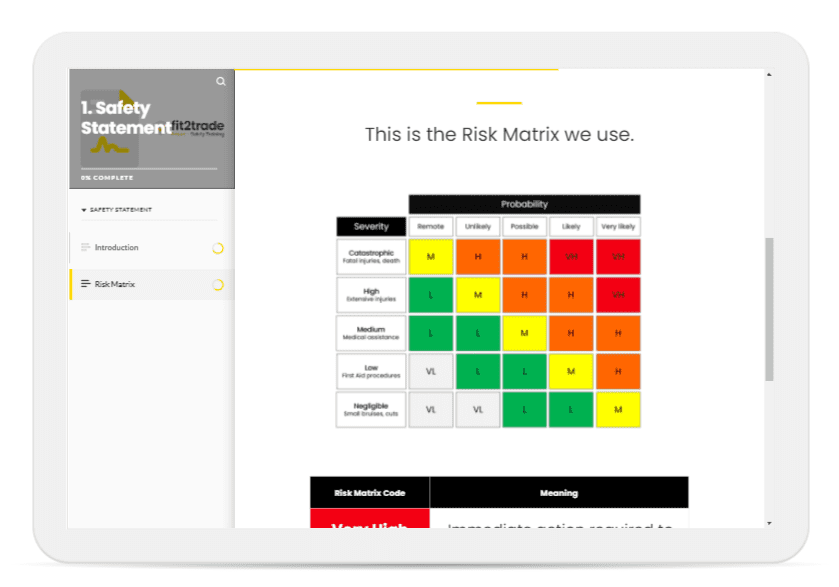Digital site-specific Safety Statements
The online safety statement we write is deployed to all employees. Get peace of mind with real-time data on who read and signed it.

The difference between a H&S Statement and a H&S Policy
A Health & Safety (H&S) Statement and a H&S Policy are both crucial for ensuring a safe working environment, but they serve slightly different purposes.
A H&S Policy is more comprehensive. It’s a formal, written statement detailing an organization’s commitment to maintaining a safe and healthy workplace. This policy outlines the overarching principles, objectives, and strategies to manage health and safety risks, and it often includes responsibilities of both employers and employees.
On the other hand, a H&S Statement, often part of the broader policy, is a concise declaration of the organization’s general intentions and principles regarding health and safety. It’s more about setting the tone or the ethos of the company regarding health and safety, often signed by the highest level of management to show commitment.
The Policy is the detailed blueprint for safety in your business, and The Statement as the compelling promise or commitment towards health and safety from your company’s leadership. Both are vital, with the policy delving into specifics and the statement reinforcing commitment at the highest level.
Which is a legal requirement in the US, UK and Ireland?
United States:
There isn’t a specific legal requirement for a H&S Policy or Statement like in the UK or Ireland. However, the Occupational Safety and Health Administration (OSHA) requires employers to provide a safe and healthful workplace and may require policies or programs related to specific workplace hazards.
United Kingdom:
H&S Policy: It’s a legal requirement for all employers with five or more employees to have a written H&S Policy. This policy should outline the organization’s approach to managing health and safety.
H&S Statement: Often part of the H&S Policy, the statement (or ‘statement of intent’) sets out the company’s commitment to health and safety. It’s usually signed by the highest level of management.
Ireland:
H&S Statement: Under the Safety, Health and Welfare at Work Act 2005, all employers, regardless of the number of employees, must prepare a Safety Statement. This is a written document that specifies how health and safety is going to be managed within the business and it reflects the commitment to their employees’ well-being.
H&S Policy: While not distinctly mentioned like the Safety Statement, a comprehensive H&S Policy is often integral to effectively managing health and safety and may be expected, especially in larger organizations.
So, in summary, the UK and Ireland have specific legal requirements for written H&S documents, with the Safety Statement being particularly emphasized in Ireland. The US, while not requiring these specific documents, mandates a general obligation for a safe workplace through OSHA regulations.
At Fit2Trade we create and deploy a Safety File to all employees
The Safety File includes 4 digital modules auto-deployed to all employees.
Safety Statement
Your commitment to health and safety.
Safety Policies
Your Health & Safety Policies and Procedures.
Risk Register
A list of the Risk Assessments in place.
Declaration
Employees declare their understanding.
Do you need SOPs?
SOPs, or Standard Operating Procedures, are a set of step-by-step instructions compiled by an organization to help workers carry out complex routine operations. Their primary purpose is to achieve efficiency, quality output, and uniformity of performance, while reducing miscommunication and failure to comply with industry regulations.
They are particularly crucial in fields where tasks are complex, require a sequence of steps to be performed in a specific order, involve the use of various tools or technologies, or where compliance with laws and regulations is essential. SOPs are prevalent in healthcare, pharmaceuticals, food and beverage, manufacturing, and any other sector where precise guidelines are necessary to ensure the safety and effectiveness of operations.
A well-written SOP will include:
- Purpose: A clear description of the procedure’s objectives and potential benefits.
- Scope: A delineation of where the SOP applies, its limits, and how it’s intended to be used.
- Procedure: The step-by-step instructions on how to perform the task.
- Roles and Responsibilities: Who is involved in the process and what are their responsibilities.
- Materials and Resources: List of all the equipment, materials, tools, etc., needed to complete the procedure.
- Health and Safety Warnings: Any potential hazards associated with the procedure, and how to handle them.
- Quality Control Points: Specific stages within the procedure where checks are performed to ensure quality and correctness.
- Record Keeping: Information on how records should be kept, what should be recorded, and for how long.

We create, digitize and deploy your SOPS to all employees
We write your Safety Policies and Procedures, then deploy them to all employees to read and declare their understanding.
Get compliance training that works.
fit2trade’s online compliance solutions make learning easy for employees and less work for HR, L&D and OH&S managers.
